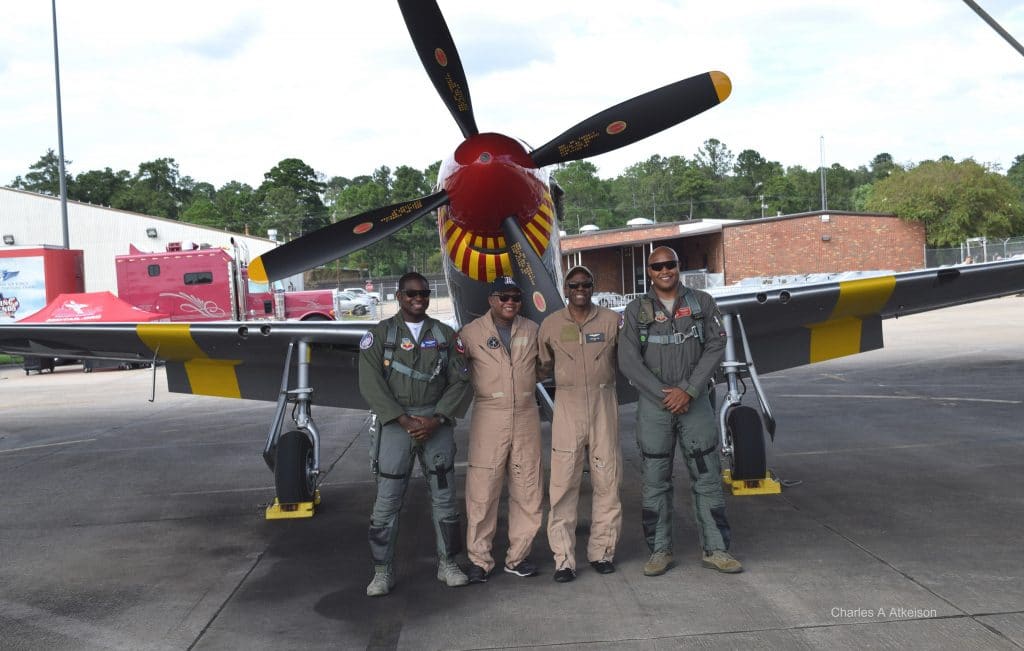MONTGOMERY, Ala. — The legacy of the Red Tails of the Tuskegee Airmen was honored recently as the warbirds of yesterday and today soared together during a special flight across the blue skies of central Alabama.
Two Red Tailed F-16 Fighting Falcons from the 100th Fighter Squadron near Montgomery took off from Dannelly Airfield to join an F-22 Raptor and a Red Tailed P-51C Mustang for a special tandem flight on September 6. Of historical interest, each aircraft was piloted by American-American.

The Montgomery air base continues to honor the legacy of the Tuskegee Airmen who became the first group of African-American military aviators, maintainers, and navigators who held support jobs at the start of World War II. On the flight line of the 100th FS rests four gray F-16 jets painted with the famous Red Tails on it vertical stabilizer.
“The 100th Fighter Squadron was one of the Tuskegee Airmen squadrons during World War II, a famous all African-American squadron from the 332d Fighter Group, activated on Feb 19, 1942 at Tuskegee Army Air Field, Alabama,” Spokesperson SSgt. Jared Rand explained. “It was returned to duty in 2007 as a replacement of the Alabama Air National Guard’s 160th Fighter Squadron so the state could honor the legacy of the Tuskegee Airmen.”
Major Paul “Loco” Lopez is the commander and pilot of the F-22 Raptor Demonstration Team based at the 301st Fighter Squadron at Langley AFB. Last November, he earned the distinction of becoming the team’s first African-American leader.

“We all stand on the shoulders of giants,” Maj. Lopez said from Dannelly Field prior to the historic flight. “If you look around on the ramp (here) you see how the military, particularly the Air Force, values preserving our legacy and honoring our heritage by painting Red Tails on to the F-16s of the 100th Fighter Squadron.”
An Army Air Corps program started in 1941, the Tuskegee Airmen was an experiment begun to train African-American men to pilot, navigate, and maintain military aircraft. As war spread across Europe, the Red Tail aircraft was woven into the Allied armies.
Air Force Maj. Rich “Sheriff” Peace of the 100th FS piloted the lead F-16 during the legacy flight that Thursday afternoon. His F-16 served as the lead with a second Fighting Falcon in flight to photograph the historic event.
“The legacy flight was to honor the memory of the Tuskegee Airmen, and to bring visibility and light to the sacrifices they made then, what we’re doing now, and how they paved the way forward to the future,” Maj. Peace said following the flight. “To see what their work and sacrifice led to today was a pretty amazing thing. I was honored and proud to be part of it.”

Commemorative Air Force Red Tail Squadron leader Brad Lang is an African-American pilot who preserves the memory of the Tuskegee Airmen. Built in 1944, and served as a trainer during the final months of the second World War, Lang piloting the P-51C Mustang Tuskegee Airmen was the perfect aircraft to represent the fighters of yesteryear.
“The Tuskegee Airmen trained right down the road at Moton Field flying various aircraft back in the day in the 1940s,” Maj. Lopez added as we stood near two gray F-22 Raptors. “For me it’s just very humbling knowing that a lot of people went through great sacrifices that we can all be here and for me to be doing this and share the airplane (F-22) and my team with the community means the world to us.”
Today, Lopez is closing in on the completion of a very busy and successful first air show season with the team. He will continue to command and perform with the demo team during the 2019 season. For Lopez, Lang, and Peace, they are but a few of today’s pilots who carry the torch forward and the legacy of the Red Tails.
(Charles A Atkeison was the only journalist to capture the Red Tails Legacy Flight from the flight line. He reports full time on aerospace and technology. Follow his updates via social media @Military_Flight.)









